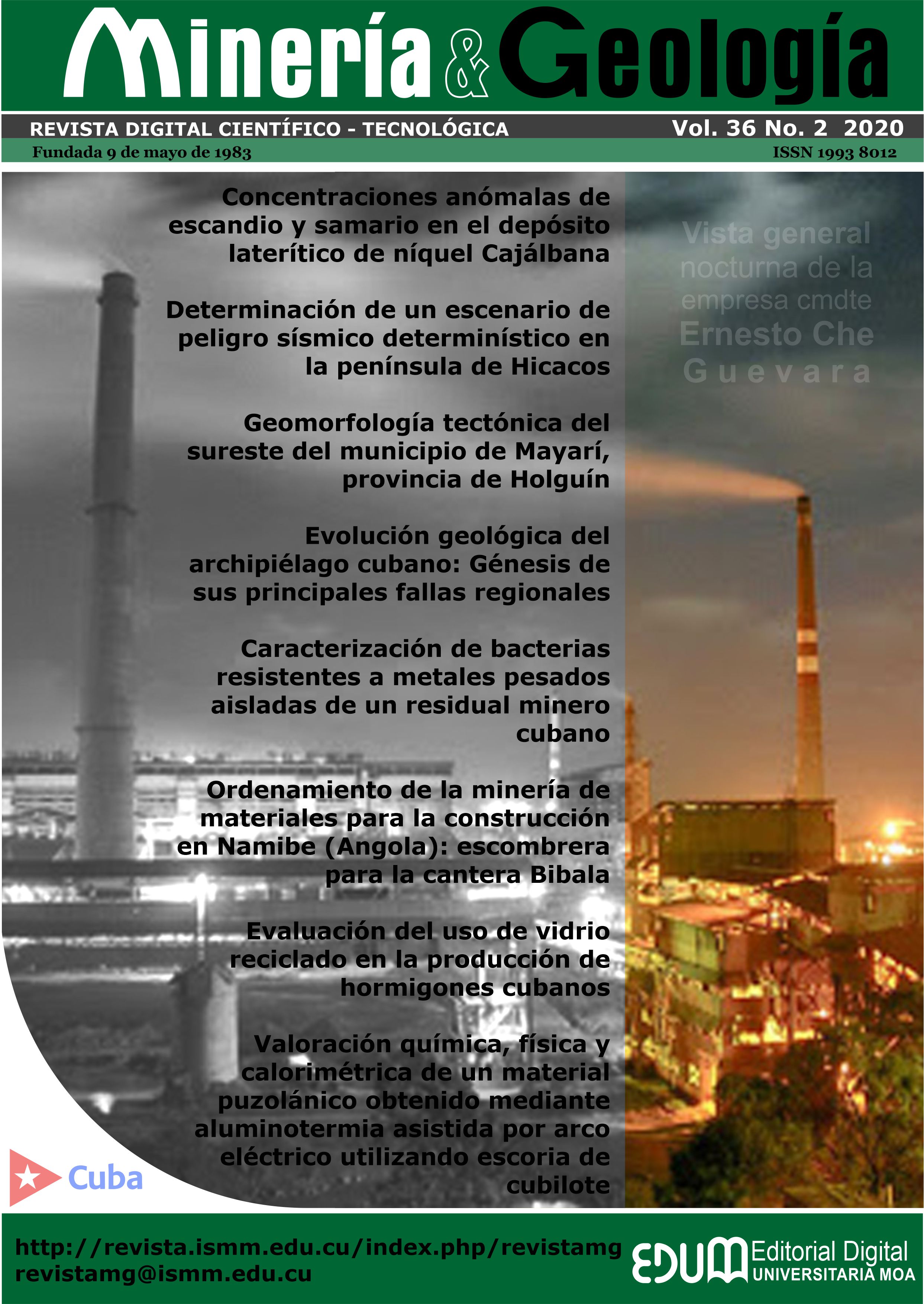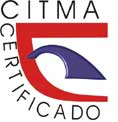Caracterización de bacterias resistentes a metales pesados aisladas de un residual minero cubano
Palabras clave:
Bacillus, escombro laterítico, resistencia a metales pesados, biorremediación.Resumen
La contaminación ambiental por metales pesados constituye un problema mundial contemporáneo. El desarrollo de estrategias biotecnológicas en el campo de la remediación ha ganado gran atención en los últimos años por ser más rentables, eficientes y amigables con el medio ambiente. Las bacterias resistentes a metales pesados constituyen una herramienta potente en la biorremediación de ambientes contaminados por metales. Este trabajo tuvo como objetivo caracterizar bacterias resistentes a metales pesados, aisladas de un escombro laterítico, residual de la industria minera de Moa. Se aislaron dos bacterias (EL-1 y EL-2) a partir del escombro laterítico. Los aislados se caracterizaron e identificaron hasta el nivel de género. Se evaluó la resistencia a níquel, cobalto, cromo y aluminio en medio mínimo Tris sólido. Se determinó la curva dosis-respuesta a níquel, cobalto, cromo y aluminio, así como el mecanismo de resistencia bacteriana a níquel. Además, se evaluó la susceptibilidad a antibióticos. Los dos aislados fueron identificados como Bacillus sp. Las cepas fueron resistentes a todos los metales evaluados, mostrando una alta resistencia a níquel (25 mmol-L-1). La cepa Bacillus sp. EL-1 presentó un mecanismo inducido de resistencia a níquel, mientras que la cepa Bacillus sp. EL-2 presentó una expresión constitutiva de la resistencia a este metal. Las bacterias mostraron un predominio de la sensibilidad a los antibióticos evaluados. Todas estas características las hacen interesantes para ser aplicadas en estrategias de biorremediación para el saneamiento ambiental.Descargas
Citas
ABOU-SHANAB, R.A.I.; VAN BERKUM, P. & ANGLE, J.S..2007: Heavy metal resistance and genotypic analysis of metal resistance genes in gram-positive and gram-negative bacteria present in Ni-rich serpentine soil and in the rhizosphere of Alyssum murale. Chemosphere. 68: 360-367.
ADEKANMBI, A. O.; ADELOWO, O. O.; OKOH I. A. & FAGADE O. E.. 2019: Metal-resistance encoding gene-fingerprints in some bacteria isolated from wastewaters of selected printeries in Ibadan, South-western Nigeria. Journal of Taibah University for Science. 13 (1): 266-273.
ALI, H.; KHAN, E. & ILAHI, I. 2019: Environmental Chemistry and Ecotoxicology of Hazardous Heavy Metals: Environmental Persistence, Toxicity, and Bioaccumulation. Hindawi Journal of Chemistry. ID 6730305. https://doi.org/10.1155/2019/6730305.
ARGUDÍN M.A., HOEFER A. & BUTAYE P.. 2019: Heavy metal resistance in bacteria from animals. Research in Veterinary Science. 122:132–147.
AZAM, M.; TASLEEM, A.; KUMAR, A.; SIDDIQUI, K.; MONDAL, A. H. & HAQ, R.. 2018: Study of pandrug and heavy metal resistance among E. coli from anthropogenically influenced Delhi stretch of river Yamuna. Brazilian Journal of Microbiology. 49:471-480.
BANJERDKIJ, P.; VATTANAVIBOON P. & MONGKOLSUK S.. 2003: Cadmium-induced adaptive resistance and cross-resistance to zinc in Xanthomonas campestris. Curr Microbiol. 47: 260–262.
BARZANTI, R.; OZINO, F.; BAZZICALUPO M.; GABBRIELLI R.; GALARDI F.; GONNELLI C. & MENGONI A.. 2007: Isolation and characterization of endophytic bacteria from the nickel hyperaccumulator plant Alyssum bertolonii. Microb. Ecol. 53(2): 306-316.
BAUER, A.W.; KIRBY M.M.; SHERRIS, J.C. & TRUCK, M.. 1966: Antibiotic susceptibility testing by a standardized single disk method. Am J Clin Pathol 42: 493.
BAZAN, G. & GALIZIA, G.. 2018: Geographical and ecological outline of metal (loid) accumulating plants in Italian vascular flora. Ecocycles 4(1): 47-64.
BRESSON, C.; DAROLLES, C.; CARMONA, A.; GAUTIER, C.; SAGE, N.; ROUDEAU, S.; ORTEGA, R.; ANSOBORLO, E. & MALARD, V.. 2013: Cobalt chloride speciation, mechanisms of cytotoxicity on human pulmonary cells, and synergistic toxicity with zinc. Metallomics. 5 (2): 85-176.
DÍAZ, A. 2013: Caracterización de la resistencia a metales de una colección bacteriana aislada del yacimiento niquelífero de Moa (Cuba) y sus potencialidades en la biorremediación ambiental de sitios contaminados por metales pesados. Jeannette Marrero Coto, José Manuel Gómez Montes de Oca, Gema Cabrera Revuelta (Tutores). Tesis Doctoral. Universidad de Cádiz. 249p.
DIELS, L.; VAN ROY, S.; TAGHAVI, S. & VAN HOUDT, R.. 2009: From industrial sites to environmental applications with Cupriavidus metallidurans. Antonie Van Leeuwenhoek. 96(2):247-58.
FAROOQ, U., KOZINSKI, J.A., AIN, K.M. & MAKSHOOF, A.. 2010: Biosorption of heavy metal ions using wheat based biosorbents. A review of the recent literature. Bioresource Technology. 101: 5043–5053.
GARCIDUEÑAS, R. P. & CERVANTES, C. (1996) Microbial interactions with aluminium. BioMetal. 9: 311- 316.
GOVIN, A.; COTO, O. & MARRERO J.. 2015: Caracterización fenotípica de una colección bacteriana aislada del yacimiento laterítico de Yagrumaje Norte, Moa, Cuba. Revista Cubana de Ciencias Biológicas 4(1):69-77.
HARRIGAN, W.F. & MCCANCE, M.E.. 1968: Métodos de Laboratorio en Microbiología. Editorial Académica. España: 62-78.
HERNÁNDEZ, I.; GALIZIA, F.; COTO, O. & DONATI, E.. 2009: Improvement in metal recovery from laterite tailings by bioleaching. Advanced Materials Research. 71-73: 489-492.
LOGAN, N. A. & DE VOS, P.. 2007: Genus I. Bacillus. En: Brenner et al. (Eds) Bergey´s Manual of Systematic Bacteriology. 2da Edición. The Firmicutes, 21-127.
LÓPEZ, D. P.; TORRES-CAYCEDO, M. I. & PRADA-QUIROGA, C. F.. 2015: Genes de resistencia en bacilos Gram negativos: Impacto en la salud pública en Colombia. Rev Univ.Salud.18(1):190-202.
MADIGAN, J., MARTINKO B. & PARKER J.. 2019: Microbial Growth and Its Control. En: Biology of Microorganisms. Ed. Prentice Hall, New Jersey, 1058 p.
MARGESIN, R & SCHINNER, F.. 1996: Bacterial heavy metal tolerance extreme resistance to nickel in Arthrobacter spp. Strains. Basic Microbiol.36: 269–282.
MARRERO, J.. 2008: Estudio molecular de la resistencia a níquel y cobalto en Serratia marcescens cepa C-1. Dra. Lila Castellanos Serra, Dr. Dietrich Nies (Tutores). Universidad de La Habana. 103p.
MARRERO, J.; AULING, G.; COTO, O. & NIES, D. H.. 2007: High-Level Resistance to Cobalt and Nickel but Probably No Transenvelope Efflux: Metal Resistance in the Cuban Serratia marcescens strain C-1. Microbial Ecology. 53: 123–133.
MARRERO, J.; COTO, O. & SCHIPPERS, A.. 2016: Anaerobic and aerobic reductive dissolution of iron-rich nickel laterite overburden by Acidithiobacillus Hydrometallurgy. 10.1016/j.hydromet.2016.08.012.
MARZAN, L. W.; HOSSAIN, M.; MINA S. K.; AKTER Y. & MASUDUL A. M.. 2017: Isolation and biochemical characterization of heavy-metal resistant bacteria from tannery effluent in Chittagong city, Bangladesh: Bioremediation viewpoint. Egyptian Journal of Aquatic Research and Fisheries. 43: 65–74.
MERGEAY, M.; NIES L. D., SCHLEGEL H.G., GERITS J., CHARLES P. & VAN GIJSEGEM F.. 1985: Alcaligenes eutrophus CH34 Is a Facultative Chemolithotroph with Plasmid-Bound Resistance to Heavy Metals. J Bacteriol. 162(1): 328-334.
NIES D. H.. 2000: Heavy metal resistant bacteria as extremophiles: molecular physiology and biotechnological use of Ralstonia sp. CH34. Extremophiles. 4: 77–82.
NIES D. H.. 2003: Efflux-mediated heavy metal resistance in prokaryotes. FEMS Microbiol Rev. 27: 313-339.
NWAGWU, C. E., MOLTONG, V., EUCHARIA, N. & ONWUMERE, G. B.. 2017: Isolation and characterization of heavy metal tolerant bacteria from Panteka stream, Kaduna, Nigeria and their potential for bioremediation. African Journal of Biotechnology. 16(1):32-40.
PAL, C.; BENGTSSON-PALME J.; KRISTIANSSON E. & JOAKIM LARSSON D. G.. 2015: Co-ocurrence of resistance genes to antibiotics, biocides and metals reveals novel insights into their co-selection potential. BMC Genomics. 16:964.
PALACIOS, A. & GARCÍA, E.. 2014: Extracción de cobalto de escombros lateríticos mediante lixiviación ácida. Minería y Geología. 30 (2): 73-86.
REEVES, R.; BAKER, A.J.M.; BORHIDI, A. & BERAZAIN R.. 1999: Nickel hiperaccumulation in the serpentine flora of Cuba. Annals of Botany. 83: 29-38.
SAMANTA, A.; BERA P.; KHATUN M.; SINHA C.; PAL P.; LALEE, A. & MANDAL, A.. 2012: An investigation on heavy metal tolerance and antibiotic resistance properties of bacterial strain Bacillus sp. isolated from municipal waste. Journal of Microbiology and Biotechnology Research. J. Microbiol. Biotech. Res. 2 (1):178-189.
SCHEDLBAUER J. L.. 2015: Serpentine ecosystem responses to varying water availability and prescribed fire in the U.S. Mid-Atlantic region. Ecosphere. 6(7):108. http://dx.doi.org/10.1890/ES14-00528.1.
SIDHU, A. K.; METKAR, G. J.; NANDURIKAR, S. P. & PATIL, S. N.. 2015: An Investigation on Metal Tolerance and Antibiotic Resistance Properties of Bacterial Strains Isolated From Two Different Drinking Water Sources. Int. J. Curr. Microbiol. App. Sci. 4(2): 305-313.
TURGAY, O. C.; GÖRMEZ, A. & BILEN, S.. 2012: Isolation and characterization of metal resistant-tolerant rhizosphere bacteria from the serpentine soils in Turkey. Environ Monit Assess. DOI 10.1007/s10661-011-1984-z.
VALCARCE, R. M. & ROJAS, I. S.. 2017: Análisis euclidiano de agrupación aplicado al estudio del yacimiento Yagrumaje Oeste. Revista Cubana de Ingeniería. 8 (2): 3 - 10.
Publicado
Cómo citar
Número
Sección
Derechos de autor 2020 Alexander Govin Sanjudo

Esta obra está bajo una licencia internacional Creative Commons Atribución-NoComercial 4.0.
Los autores que publican en esta revista están de acuerdo con los siguientes términos:
- Licencia Creative Commons Atribución-NoComercial permite que el beneficiario de la licencia tenga el derecho de copiar, distribuir, exhibir y representar la obra y hacer obras derivadas para fines no comerciales siempre y cuando reconozca y cite la obra de la forma especificada por el autor o el licenciante.
- Los autores pueden establecer por separado acuerdos adicionales para la distribución no exclusiva de la versión de la obra publicada en la revista (por ejemplo, situarlo en un repositorio institucional o publicarlo en un libro), con un reconocimiento de su publicación inicial en esta revista.
- Se permite y se anima a los autores a difundir sus trabajos electrónicamente (por ejemplo, en repositorios institucionales o en su propio sitio web) antes y durante el proceso de envío, ya que puede dar lugar a intercambios productivos, así como a una citación más temprana y mayor de los trabajos publicados (Véase The Effect of Open Access) (en inglés).
- Lo anterior debe realizarse siempre sobre el artículo ya publicado por Minería y Geología.
La revista permite que los autores tengan los derechos de autor sin restricciones
La revista permite que los autores conserven los derechos de publicación sin restricciones










